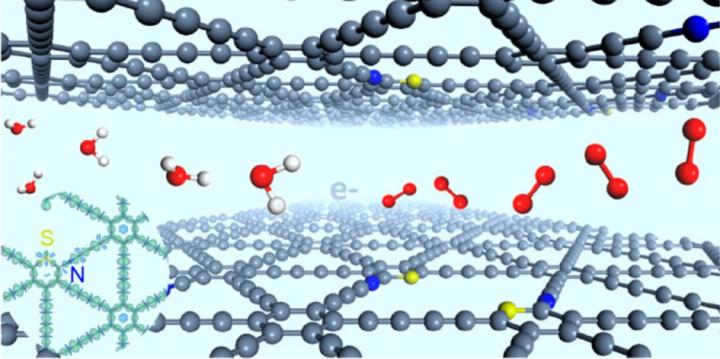Scientists develop stereodefined N and S atom-codoped graphdiyne for oxygen evolution

Stereodefined sp-N and S atoms for efficient oxygen evolution. Credit: ZHAO Yasong
Traditional OER catalysts, e.g. RuO2 and IrO2, are limited by high cost and declining stability. Heteroatom-doped carbon materials, especially dual doping, have displayed intriguing potential for highly efficient electrocatalysis owing to the synergistic effect.
However, the doping sites for different atoms are highly uncontrollable, which makes the structure-property study difficult.
The synergistic effect can only take place within a certain distance between the dual atoms, and 7.5 Å is the upper limit for N and S atoms to obtain a strong synergistic effect.
Scientists from the Institute of Process Engineering (IPE) of the Chinese Academy of Sciences successfully prepared “stereodefined” N and S atoms codoped graphdiyne, and the relative positions of the N and S atoms were well controlled.
“N-, S-codoped graphdiyne presented higher catalytic activity than those catalysts with individual-element doping (N or S atom) and commercial RuO2 in catalyzing the OER, possessing lower overpotential (299 mV) and higher current density (47.2 mA/cm2, 1.6 V), ” said WANG Dan, who led this research.
This study opens an avenue for understanding the synergistic effects in heteroelement-doped metal-free catalysts, and for further guiding the rational design and preparation of highly efficient catalysts for energy conversion and storage.
Media Contact
More Information:
http://dx.doi.org/10.1021/jacs.8b13695All latest news from the category: Life Sciences and Chemistry
Articles and reports from the Life Sciences and chemistry area deal with applied and basic research into modern biology, chemistry and human medicine.
Valuable information can be found on a range of life sciences fields including bacteriology, biochemistry, bionics, bioinformatics, biophysics, biotechnology, genetics, geobotany, human biology, marine biology, microbiology, molecular biology, cellular biology, zoology, bioinorganic chemistry, microchemistry and environmental chemistry.
Newest articles

A ‘language’ for ML models to predict nanopore properties
A large number of 2D materials like graphene can have nanopores – small holes formed by missing atoms through which foreign substances can pass. The properties of these nanopores dictate many…

Clinically validated, wearable ultrasound patch
… for continuous blood pressure monitoring. A team of researchers at the University of California San Diego has developed a new and improved wearable ultrasound patch for continuous and noninvasive…

A new puzzle piece for string theory research
Dr. Ksenia Fedosova from the Cluster of Excellence Mathematics Münster, along with an international research team, has proven a conjecture in string theory that physicists had proposed regarding certain equations….



